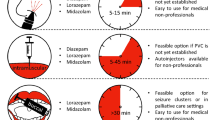Abstract
Dairy calves immobilized with xylazine (XYL) were given atipamezole-HCl (ATI) at different XYL:ATI dose ratios (w/w) for reversal and the antagonistic effect of xylazine was evaluated. Control animals received saline for comparison. Intramuscular administration of xylazine (0.139–0.357 mg/kg) induced sedation with complete immobilization in all animals (n=195) and there were no spontaneous recoveries before injection of atipamezole or saline. Atipamezole was given 10–81 min and saline 25 min after xylazine administration. Intramuscular administration of atipamezole at XYL:ATI dose ratios of 5:2 (n=11), 10:3 (n=21), 4:1 (n=21) and 5:1 (n=25) effectively antagonized the xylazine-induced immobilization and sedation. The mean times (standard deviation) from injection of atipamezole until the animals were standing for these dose ratio groups were 6.09 (3.12), 5.15 (2.87), 6.35 (2.54) and 7.86 (3.11) min, respectively. The mean time to standing for control animals (n=11) was 94.1 (3.0) min. Intravenous administration of atipamezole at XYL:ATI dose ratios of 10:3 (n=7), 4:1 (n=33), 5:1 (n=16), 8:1 (n=27) and 10:1 (n=9) rapidly reversed the xylazine-induced immobilization and sedation. The mean times (standard deviation) from injection of atipamezole until the animals were standing for these dose ratio groups were 0.98 (0.22), 1.32 (0.48), 1.09 (0.34), 1.39 (0.52) and 1.60 (0.69) min, respectively. The mean time to standing for control animals (n=14) was 88.1 (13.1) min.
Animals given high doses of atipamezole (dose ratio groups 5:2 intramuscularly, 10:3 intravenously and 4:1 intravenously) showed signs of excitement while in animals given low doses of atipamezole (dose ratio groups 5:1 intramuscularly and 10:1 intravenously) resedation and relapse into recumbency occurred. Medium doses of atipamezole (dose ratio groups 10:3 intramuscularly, 4:1 intramuscularly, 5:1 intravenously and 8:1 intravenously) did not cause any undesirable side-effects or resedation, and can be recommended for reversal of xylazine-induced sedation in dairy calves
Similar content being viewed by others
Abbreviations
- ATI:
-
atipamezole-HCl
- BW:
-
body weight
- IM:
-
intramuscular
- IV:
-
intravenous
- SD:
-
standard deviation
- XYL:
-
xylazine
References
Benson, G.J. and Thurmon, J.C., 1986. Regional analgesia. In: J.L. Howard (ed.),Current Veterinary Therapy 2: Food Animal Practices, (W.B. Saunders, Philadelphia), 71–83
Green, S.A. and Thurmon, J.C., 1988. Xylazine — a review of its pharmacology and use in veterinary medicine.Journal of Veterinary Pharmacology and Therapeutics,11, 295–313
Guard, C.L. and Schwark, W.S., 1984. Influence of yohimbine on xylazine-induced depression of central nervous, gastrointestinal and cardiovascular function in the calf.Cornell Veterinarian,74, 312–321
Hall, L.W. and Clarke, K.W., 1991.Veterinary Anaesthesia, 9th edn, (Baillière Tindall, London), 238–239
Jalanka, H., 1987. Clinical-pharmacological properties of a new sedative — medetomidine — and its antagonist, MPV-1248.Proceedings of the 1st International Conference on Zoological and Avian Medicine, Hawaii, 1987, 530–534
Jalanka, H.H. and Roeken, B.O., 1990. The use of medetomidine, medetomidine-ketamine combinations, and atipamezole in nondomestic mammals: a review.Journal of Zoo and Wildlife Medicine,21, 259–282
Jarvis, N. and England, G.C.V., 1991. Reversal of xylazine sedation in dogs.Veterinary Record,128, 323–325
Luna, S.P.L., Beale, N.J. and Taylor, P.M., 1992. Effects of atipamezole on xylazine sedation in ponies.Veterinary Record,130, 268–271
Raekallio, M., Leino, A., Vainio, O. and Scheinin, M., 1992. Sympatho-adrenal activity and the clinical sedative effect of detomidine in horses.Equine Veterinary Journal, suppl. 11 66–68
Thompson, J.R., Kersting, K.W. and Hsu, W.H., 1991. Antagonistic effect of atipamezole on xylazine-induced sedation, bradycardia, and ruminal atony in calves.American Journal of Veterinary Research,52, 1265–1268
Thurmon, J.C., 1986. Injectable anesthetic agents and techniques in ruminants and swine.Veterinary Clinics of North America: Food Animal Practice,2, 567–591
Thurmon, J.C. and Benson, G.J., 1986. Anesthesia in ruminants and swine. In: J.L. Howard (ed.),Current Veterinary Therapy 2: Food Animal Practice, (W.B. Saunders, Philadelphia), 51–71
Thurmon, J.C. and Benson, G.J., 1993. Anesthesia in ruminants and swine. In: J.L. Howard (ed.),Current Veterinary Therapy 3: Food Animal Practice, (W.B. Saunders, Philadelphia), 58–76
Thurmon, J.C., Lin, H.C., Tranquilli, W.J., Benson, G.J. and Olson, W.A., 1989. A comparison of yohimbine and tolazoline as antagonist of xylazine sedation in calves (abstract).Veterinary Surgery,18, 170–171
Van Metre, D.C., 1992. A case report of the treatment of an overdose of xylazine in a cow.Cornell Veterinarian,82, 287–291
Virtanen, R., Savola, J.-M. and Saano, V., 1989. Highly selective and specific antagonism of central and peripheral α2-adrenoceptors by atipamezole.Archives Internationales de Pharmacodynamie et de Therapie,297, 190–204
Author information
Authors and Affiliations
Rights and permissions
About this article
Cite this article
Arnemo, J.M., Søli, N.E. Reversal of xylazine-induced sedation in dairy calves with atipamezole: A field trial. Vet Res Commun 17, 305–312 (1993). https://doi.org/10.1007/BF01839221
Accepted:
Issue Date:
DOI: https://doi.org/10.1007/BF01839221




